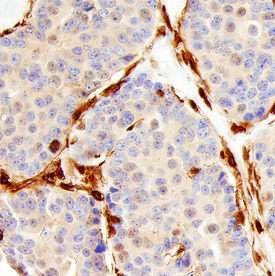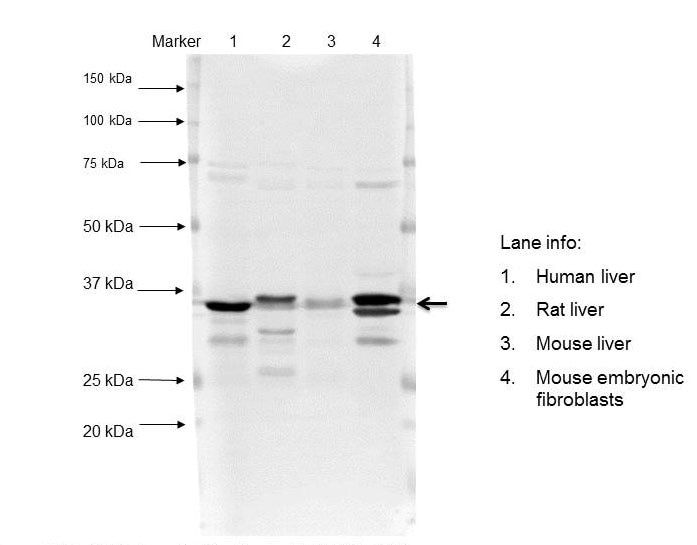Human/Mouse/Rat Annexin A1 Antibody Summary
Met1-Asn346
Accession # P04083
Applications
Please Note: Optimal dilutions should be determined by each laboratory for each application. General Protocols are available in the Technical Information section on our website.
Scientific Data
 View Larger
View Larger
Detection of Human/Mouse/Rat Annexin A1 by Western Blot. Western blot shows lysates of MOLT-4 human acute lymphoblastic leukemia cell line, NIH-3T3 mouse embryonic fibroblast cell line, and L6 rat myoblast cell line. PVDF membrane was probed with 0.2 µg/mL of Goat Anti-Human/Mouse/Rat Annexin A1 Antigen Affinity-purified Polyclonal Antibody (Catalog # AF3770) followed by HRP-conjugated Anti-Goat IgG Secondary Antibody (Catalog # HAF109). A specific band was detected for Annexin A1 at approximately 35-40 kDa (as indicated). This experiment was conducted under reducing conditions and using Immunoblot Buffer Group 2.
 View Larger
View Larger
Annexin A1/Annexin I in Human Breast. Annexin A1/Annexin I was detected in immersion fixed paraffin-embedded sections of human breast using Goat Anti-Human/Mouse/Rat Annexin A1/Annexin I Antigen Affinity-purified Polyclonal Antibody (Catalog # AF3770) at 10 µg/mL overnight at 4 °C. Before incubation with the primary antibody, tissue was subjected to heat-induced epitope retrieval using Antigen Retrieval Reagent-Basic (Catalog # CTS013). Tissue was stained using the Anti-Goat HRP-DAB Cell & Tissue Staining Kit (brown; Catalog # CTS008) and counter-stained with hematoxylin (blue). Specific staining was localized to stromal cells. View our protocol for Chromogenic IHC Staining of Paraffin-embedded Tissue Sections.
 View Larger
View Larger
Detection of Human and Mouse Annexin A1 by Simple WesternTM. Simple Western lane view shows lysates of MOLT-4 human acute lymphoblastic leukemia cell line and NIH-3T3 mouse embryonic fibroblast cell line, loaded at 0.2 mg/mL. A specific band was detected for Annexin A1 at approximately 44 kDa (as indicated) using 2 µg/mL of Goat Anti-Human/Mouse/Rat Annexin A1 Antigen Affinity-purified Polyclonal Antibody (Catalog # AF3770) followed by 1:50 dilution of HRP-conjugated Anti-Goat IgG Secondary Antibody (Catalog # HAF109). This experiment was conducted under reducing conditions and using the 12-230 kDa separation system.
Reconstitution Calculator
Preparation and Storage
- 12 months from date of receipt, -20 to -70 °C as supplied.
- 1 month, 2 to 8 °C under sterile conditions after reconstitution.
- 6 months, -20 to -70 °C under sterile conditions after reconstitution.
Background: Annexin A1
The Annexins are a family of Calcium-dependent phospholipid-binding proteins that are preferentially located on the cytosolic face of the plasma membrane. The Annexin’s have a molecular weight of approximately 35 to 40 kDa and consist of a unique amino terminal domain followed by a homologous C-terminal core domain containing the calcium-dependent phospholipid-binding sites. The C‑terminal domain is comprised of four 60‑70 amino acid repeats, known as annexin repeats or an endonexin fold (Annexin A6 contains 8 annexin repeats). The four annexin repeats form a highly alpha -helical, tightly packed disc known as the annexin domain, which binds to phospholipids in the membrane in a calcium-dependent manner. Members of the annexin family play a role in cytoskeletal interactions, phospholipase inhibition, regulation of cellular growth, and intracellular signal transduction pathways. Annexin A1 (ANXA1), also known as annexin I, lipocortin I, and calpactin II, is an ~ 40 kDa protein with phospholipase A2 inhibitory activity. Since phospholipase A2 is required for the biosynthesis of the potent mediators of inflammation, prostaglandins and leukotrienes, Annexin A1 may have anti-inflammatory activity. Human Annexin A1 shares 88 and 89% identity with mouse and rat Annexin A1, respectively.
Product Datasheets
Citations for Human/Mouse/Rat Annexin A1 Antibody
R&D Systems personnel manually curate a database that contains references using R&D Systems products. The data collected includes not only links to publications in PubMed, but also provides information about sample types, species, and experimental conditions.
3
Citations: Showing 1 - 3
Filter your results:
Filter by:
-
Secreted KIAA1199 promotes the progression of rheumatoid arthritis by mediating hyaluronic acid degradation in an ANXA1-dependent manner
Authors: W Zhang, G Yin, H Zhao, H Ling, Z Xie, C Xiao, Y Chen, Y Lin, T Jiang, S Jin, J Wang, X Yang
Cell Death & Disease, 2021-01-20;12(1):102.
Species: Human
Sample Types: Whole Tissue
Applications: IHC -
Phenotypic and Expressional Heterogeneity in the Invasive Glioma Cells
Authors: A Fayzullin, CJ Sandberg, M Spreadbury, BM Saberniak, Z Grieg, E Skaga, IA Langmoen, EO Vik-Mo
Transl Oncol, 2018-10-03;12(1):122-133.
Species: Human
Sample Types: Whole Cells
Applications: ICC -
A role for stroma-derived annexin A1 as mediator in the control of genetic susceptibility to T-cell lymphoblastic malignancies through prostaglandin E2 secretion.
Authors: Santos J, Gonzalez-Sanchez L, Matabuena-Deyzaguirre M, Villa-Morales M, Cozar P, Lopez-Nieva P, Fernandez-Navarro P, Fresno M, Diaz-Munoz MD, Guenet JL, Montagutelli X, Fernandez-Piqueras J
Cancer Res., 2009-02-24;69(6):2577-87.
Species: Mouse
Sample Types: Cell Lysates
Applications: Western Blot
FAQs
No product specific FAQs exist for this product, however you may
View all Antibody FAQsReviews for Human/Mouse/Rat Annexin A1 Antibody
Average Rating: 4 (Based on 1 Review)
Have you used Human/Mouse/Rat Annexin A1 Antibody?
Submit a review and receive an Amazon gift card.
$25/€18/£15/$25CAN/¥75 Yuan/¥2500 Yen for a review with an image
$10/€7/£6/$10 CAD/¥70 Yuan/¥1110 Yen for a review without an image
Filter by:


